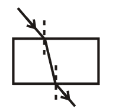
Four students showed the following traces of the path of a ray of light passing through a rectangular glass slab. The trace most likely to be correct is that of student:

A. I
B. II
C. III
D. IV

Answer
556.2k+ views
Hint:First of all, we will observe all the figures and closely observe the incident ray and the emergent ray. The refracted angle is smaller than the incident angle. The incident ray and the emergent ray both should be inclined at zero degree.
Complete answer:
In the given question, we are supplied the following data:
Four observations are given which were made after the tracing the path of a ray of light passing through a rectangular glass slab.We are asked to find out which one of the following observations are correct according to the principle of refraction.
To begin with, we will discuss a bit about refraction of light through a rectangular slab. When a light ray enters the glass slab, it is incident at a certain angle which we call the angle of incidence. The ray then suffers bending at the foot of the normal while entering the glass slab. The ray inside the glass slab bends more towards the normal, which we can say that the angle of incidence is more than that of the angle of refraction. The ray emerging out of the glass slab finally, must be parallel to the incident ray.
However, in the figures I, II and IV we can see that the incident ray and the emergent ray in all the cases are not parallel to each other. These figures contain errors in them, which may be the observer’s problem. But in the figure IV, we can see that the incident ray and the emergent ray are both parallel to each other, and where we can show the phenomenon of refraction taking place.

Hence, the correct observation is by the third student.
The correct option is C.
Note:While doing this problem, we should keep in mind that the angle of refraction is less than that angle of incidence. The emergent angle is the same as that of the angle of incidence. The angles are measured as the inclination of the ray with the normal. The normal is present at every point where the incident ray hits.
Complete answer:
In the given question, we are supplied the following data:
Four observations are given which were made after the tracing the path of a ray of light passing through a rectangular glass slab.We are asked to find out which one of the following observations are correct according to the principle of refraction.
To begin with, we will discuss a bit about refraction of light through a rectangular slab. When a light ray enters the glass slab, it is incident at a certain angle which we call the angle of incidence. The ray then suffers bending at the foot of the normal while entering the glass slab. The ray inside the glass slab bends more towards the normal, which we can say that the angle of incidence is more than that of the angle of refraction. The ray emerging out of the glass slab finally, must be parallel to the incident ray.
However, in the figures I, II and IV we can see that the incident ray and the emergent ray in all the cases are not parallel to each other. These figures contain errors in them, which may be the observer’s problem. But in the figure IV, we can see that the incident ray and the emergent ray are both parallel to each other, and where we can show the phenomenon of refraction taking place.

Hence, the correct observation is by the third student.
The correct option is C.
Note:While doing this problem, we should keep in mind that the angle of refraction is less than that angle of incidence. The emergent angle is the same as that of the angle of incidence. The angles are measured as the inclination of the ray with the normal. The normal is present at every point where the incident ray hits.
Recently Updated Pages
Master Class 10 General Knowledge: Engaging Questions & Answers for Success

Master Class 10 Science: Engaging Questions & Answers for Success

Master Class 10 Social Science: Engaging Questions & Answers for Success

Master Class 10 Maths: Engaging Questions & Answers for Success

Master Class 10 English: Engaging Questions & Answers for Success

Master Class 10 Computer Science: Engaging Questions & Answers for Success

Trending doubts
The shortest day of the year in India

10 examples of evaporation in daily life with explanations

A Gulab jamun contains sugar syrup up to about 30 of class 10 maths CBSE

What is UltraEdge (Snickometer) used for in cricket?

On the outline map of India mark the following appropriately class 10 social science. CBSE

Why does India have a monsoon type of climate class 10 social science CBSE




